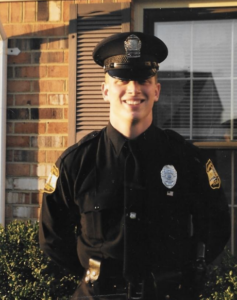First Responder Reset
Restorative Therapies that incorporate Hyperbaric Oxygen Therapy, Neurofeedback and Near Infrared Light Therapy

About the Treatment
THE PROBLEM:
First Responders are suffering from depression, anxiety, post traumatic stress and injury. First Responders incur multiple injuries and are exposed to primary and secondary trauma throughout their careers. Repeated exposure to trauma results in psychological distress similar to the traumatized victims. Preliminary results released in May 2022 by the Virginia Association of Chiefs of Police summarized answers from 2,635 first responders, or about 20% of all first responders across the state. Clinical scores revealed as much as 20% of officers who responded are experiencing moderate to severe depression and/or anxiety, post traumatic stress, problems with alcohol and thoughts of suicide.
Of law enforcement respondents who received scores of clinical significance, the vast majority did not have a formal diagnosis (69% for depression, 74% for anxiety, 73% for PTS).
A Simple Process
- Patients will meet with our patient care coordinator for initial assessment and discuss treatment goals.
- Based on assessment results, a personalized treatment protocol is developed for the treatment modality or a combination of modalities best suited for the condition or injury, which may include hyperbaric oxygen therapy, neurofeedback and near infrared light therapy.
- Patients will meet with our staff physician for a medical evaluation and be cleared for treatment.
- The protocol is implemented.
- Post clinical assessments will be conducted within seven days of completion to determine treatment effectiveness.
- Patients will meet with our patient care coordinator to discuss results, any follow-on therapy and self-care beyond treatment.
THE SOLUTION: Hyperbaric Oxygen Therapy, Neurofeedback and Near Infrared Light Therapy
The power of hyperbaric oxygen therapy is in the processes that occur in the body when breathing 100% oxygen at simulated depths below sea level. It works at the mitochondrial level to “kick start” functionality and helps to:
- Reduce inflammation
- Create new blood vessels (angiogenesis)
- Improve cellular functions
- Trigger the mobilization and growth of new stem cells
HBOT has been used to treat decompression sickness for more than 75 years. It is used daily in hospitals to heal wounds. Here, we use HBOT to heal wounds in the brain and inside the body. Studies show the efficacy of HBOT for numerous other health conditions including depression, anxiety, symptoms of post traumatic stress and physical injuries. Additional research shows that HBOT used in conjunction with other brain therapies, such as biofeedback/neurofeedback, makes that therapy even more effective.
Biofeedback/Neurofeedback is a drug-free, non-invasive way to measure brainwave activity and treat common mental health challenges.
- Using QEEG, we can identify brain wave imbalances and irregularities.
- After careful analysis of the data, we can accurately address the irregularity in brainwave activity to effectively treat the condition.
- A 2022 retrospective study of 593 participants demonstrated the effectiveness of remote neurofeedback in improving depression, anxiety and cognitive decline.
Neurofeedback has been used since the 1970’s as an adjunctive therapy for a variety of psychiatric disorders including generalized anxiety, depression, post traumatic stress and addictive disorders. Each emotion and behavior we have has associated brainwaves. Using QEEG, we can identify brain wave imbalances and irregularities. After careful analysis of the data, we can accurately address the irregularity in brainwave activity to effectively treat common mental health challenges or conditions. A 2022 retrospective study of 593 participants demonstrated the effectiveness of remote neurofeedback in improving depression, anxiety and cognitive decline.
The human brain is changeable, which means it will respond to conditioning. Through a series of neurofeedback sessions, the brain can learn how to self-regulate. It is similar to the idea of physical conditioning, where a person’s muscles grow stronger with repeated exercise. Click here to see a success story of how the military is testing the effectiveness of neurofeedback to treat concussion or mild traumatic brain injury in soldiers to improve emotional issues and sleep disturbance.
Near infrared light therapy is an adjunct therapy currently being used in clinical and home settings around the world. It triggers the release of nitric oxide from blood vessels and red blood cells. Nitric oxide causes local vasodilation that lasts several hours after the therapy session has ended. Vasodilation improves blood flow. Improving blood flow lessens pain and helps nerves to begin to carry sensations again.
Ted’s Story
 Retired Virginia Beach Police Officer, Ted Marriner, was hit by a drunk driver in 2005. He was diagnosed with a mild traumatic brain injury and had been suffering with postconcussion syndrome (PCS) for 9 years. His chronic symptoms included headaches, disrupted sleep cycles. balance issues, anger outbursts and cognitive issues to name a few. Studies show HBOT improves symptoms of PCS months or even years after the original injury. Click here to hear Ted’s story about how hyperbaric oxygen therapy healed his brain injury, improved his symptoms and gave him his quality of life back.
Retired Virginia Beach Police Officer, Ted Marriner, was hit by a drunk driver in 2005. He was diagnosed with a mild traumatic brain injury and had been suffering with postconcussion syndrome (PCS) for 9 years. His chronic symptoms included headaches, disrupted sleep cycles. balance issues, anger outbursts and cognitive issues to name a few. Studies show HBOT improves symptoms of PCS months or even years after the original injury. Click here to hear Ted’s story about how hyperbaric oxygen therapy healed his brain injury, improved his symptoms and gave him his quality of life back.
“It took me several years of trying to find something and after so much disappointment and hopelessness, and finally finding somebody who was willing to take the ball and run with it, actually get in, get the treatment and see the difference…it works. I don’t have any question about it.”
We will develop a personalized protocol that is right for each individual.
At Tier I Therapy Centers, we specialize in restorative therapies for First Responders. We offer hyperbaric oxygen therapy, biofeedback/neurofeedback and near infrared light therapy to ensure a comprehensive, individualized treatment protocol for patients who experience a constellation of symptoms, which may include depression, anxiety, ASD, traumatic brain injury, cognitive decline, compassion fatigue, operator syndrome, post traumatic stress and trauma.
Call today and speak with one of our friendly staff members about whether or not hyperbaric oxygen therapy, neurofeedback and/or near infrared light therapy is right for you 757-452-3934.